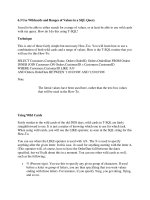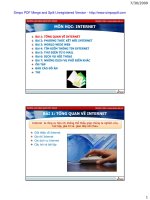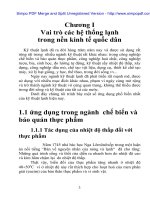Simpo PDF Merge and Split Unregistered Version -Programmer Advanced SQL Database pdf
Bạn đang xem bản rút gọn của tài liệu. Xem và tải ngay bản đầy đủ của tài liệu tại đây (2.25 MB, 116 trang )
Advanced SQL Database Programmer
Handbook
Donald K. Burleson
Joe Celko
John Paul Cook
Peter Gulutzan
Brought to you by
DBAzine.com &
BMC Software Inc.
Simpo PDF Merge and Split Unregistered Version -
Simpo PDF Merge and Split Unregistered Version -
DBAzine.com
BMC.com/oracle
iii
Advanced SQL Database Programmers
Handbook
By Donald K. Burleson, Joe Celko, John Paul Cook, and
Peter Gulutzan
Copyright © 2003 by BMC Software and DBAzine. Used with permission.
Printed in the United States of America.
Series Editor: Donald K. Burleson
Production Manager: John Lavender
Production Editor: Teri Wade
Cover Design: Bryan Hoff
Printing History:
August, 2003 for First Edition
Oracle, Oracle7, Oracle8, Oracle8i and Oracle9i are trademarks of Oracle Corporation.
Oracle In-Focus is a registered Trademark of Rampant TechPress.
Many of the designations used by computer vendors to distinguish their products are
claimed as Trademarks. All names known to Rampant TechPress to be trademark names
appear in this text as initial caps.
The information provided by the authors of this work is believed to be accurate and
reliable, but because of the possibility of human error by our authors and staff, BMC
Software, DBAZine and Rampant TechPress cannot guarantee the accuracy or
completeness of any information included in this work and is not responsible for any
errors, omissions or inaccurate results obtained from the use of information or scripts in
this work.
Links to external sites are subject to change; DBAZine.com, BMC Software and
Rampant TechPress do not control or endorse the content of these external web sites,
and are not responsible for their content.
ISBN 0-9744355-2-X
Simpo PDF Merge and Split Unregistered Version -
iv DBAzine.com
BMC.com/oracle
Table of Contents
Conventions Used in this Book vii
About the Authors ix
Foreword x
Chapter 1 - SQL as a Second Language 1
Thinking in SQL by Joe Celko 1
Chapter 2 - SQL View Internals 7
SQL Views Transformed by Peter Gulutzan 7
Syntax 7
Cheerful Little Fact #1: 8
Cheerful Little Fact #2: 8
View Merge 9
Table1 10
The Small Problem with View Merge 13
Temporary Tables 14
Permanent Materialized Views 15
UNION ALL Views 18
Alternatives to Views 19
Tips 21
References 21
Chapter 3 - SQL JOIN 25
Relational Division by Joe Celko 25
Chapter 4 - SQL UNION 31
Set Operations by Joe Celko 31
Introduction 31
Set Operations: Union 32
Chapter 5 - SQL NULL 37
Selection by Joe Celko 37
Introduction 37
Simpo PDF Merge and Split Unregistered Version -
DBAzine.com
BMC.com/oracle
v
The Null of It All 37
Defining a Three-valued Logic 39
Wonder Shorthands 40
Chapter 6 - Specifying Time 41
Killing Time by Joe Celko 41
Timing is Everything 41
Specifying "Lawful Time" 43
Avoid Headaches with Preventive Maintenance 44
Chapter 7 - SQL TIMESTAMP datatype 45
Keeping Time by Joe Celko 45
Chapter 8 - Internals of the IDENTITY datatype Column. 49
The Ghost of Sequential Processing by Joe Celko 49
Early SQL and Contiguous Storage 49
IDENTITY Crisis 50
Chapter 9 - Keyword Search Queries 53
Keyword Searches by Joe Celko 53
Chapter 10 - The Cost of Calculated Columns 57
Calculated Columns by Joe Celko 57
Introduction 57
Triggers 58
INSERT INTO Statement 60
UPDATE the Table 61
Use a VIEW 61
Chapter 11 - Graphs in SQL 63
Path Finder by Joe Celko 63
Chapter 12 - Finding the Gap in a Range 69
Filling in the Gaps by Joe Celko 69
Chapter 13 - SQL and the Web 75
Web Databases by Joe Celko 75
Simpo PDF Merge and Split Unregistered Version -
vi DBAzine.com
BMC.com/oracle
Chapter 14 - Avoiding SQL Injection 81
SQL Injection Security Threats by John Paul Cook 81
Creating a Test Application 81
Understanding the Test Application 83
Understanding Dynamic SQL 84
The Altered Logic Threat 85
The Multiple Statement Threat 86
Prevention Through Code 88
Prevention Through Stored Procedures 89
Prevention Through Least Privileges 90
Conclusion 91
Chapter 15 - Preventing SQL Worms 93
Preventing SQL Worms by John Paul Cook 93
Finding SQL Servers Including MSDE 93
Identifying Versions 96
SQL Security Tools 98
Preventing Worms 98
MSDE Issues 99
.NET SDK MSDE and Visual Studio .NET 100
Application Center 2000 101
Deworming 101
Baseline Security Analyzer 101
Conclusion 102
Chapter 16 - Basic SQL Tuning Hints 103
SQL tuning by Donald K. Burleson 103
Index 105
Simpo PDF Merge and Split Unregistered Version -
DBAzine.com
BMC.com/oracle
vii
Conventions Used in this Book
It is critical for any technical publication to follow rigorous
standards and employ consistent punctuation conventions to
make the text easy to read.
However, this is not an easy task. Within Oracle there are
many types of notation that can confuse a reader. Some Oracle
utilities such as STATSPACK and TKPROF are always spelled
in CAPITAL letters, while Oracle parameters and procedures
have varying naming conventions in the Oracle documentation.
It is also important to remember that many Oracle commands
are case sensitive, and are always left in their original executable
form, and never altered with italics or capitalization.
Hence, all Rampant TechPress books follow these conventions:
Parameters - All Oracle parameters will be lowercase italics.
Exceptions to this rule are parameter arguments that are
commonly capitalized (KEEP pool, TKPROF), these will be
left in ALL CAPS.
Variables – All PL/SQL program variables and arguments will
also remain in lowercase italics (dbms_job, dbms_utility).
Tables & dictionary objects – All data dictionary objects are
referenced in lowercase italics (dba_indexes, v$sql). This
includes all v$ and x$ views (x$kcbcbh, v$parameter) and
dictionary views (dba_tables, user_indexes).
SQL – All SQL is formatted for easy use in the code depot,
and all SQL is displayed in lowercase. The main SQL terms
(select, from, where, group by, order by, having) will always
appear on a separate line.
Simpo PDF Merge and Split Unregistered Version -
viii DBAzine.com
BMC.com/oracle
Programs & Products – All products and programs that are
known to the author are capitalized according to the vendor
specifications (IBM, DBXray, etc). All names known by
Rampant TechPress to be trademark names appear in this
text as initial caps. References to UNIX are always made in
uppercase.
Simpo PDF Merge and Split Unregistered Version -
DBAzine.com
BMC.com/oracle
ix
About the Authors
Donald K. Burleson is one of the world’s top Oracle Database
experts with more than 20 years of full-time DBA
experience. He specializes in creating database architectures
for very large online databases and he has worked with some
of the world’s most powerful and complex systems. A
former Adjunct Professor, Don Burleson has written 15
books, published more than 100 articles in national
magazines, serves as Editor-in-Chief of Oracle Internals and
edits for Rampant TechPress. Don is a popular lecturer and
teacher and is a frequent speaker at Oracle Openworld and
other international database conferences.
Joe Celko was a member of the ANSI X3H2 Database
Standards Committee and helped write the SQL-92
standards. He is the author of over 450 magazine columns
and four books, the best known of which is SQL for Smarties
(Morgan-Kaufmann Publishers, 1999). He is the Vice
President of RDBMS at Northface University in Salt Lake
City.
John Paul Cook is a database and .NET consultant. He also
teaches .NET, XML, SQL Server, and Oracle courses at
Southern Methodist University's location in Houston, Texas.
Peter Gulutzan is the co-author of one thick book about the
SQL Standard (SQL-99 Complete, Really) and one thin book
about optimization (SQL Performance Tuning). He has written
about DB2, Oracle, and SQL Server, emphasizing portability
and DBMS internals, in previous dbazine.com articles. Now
he has a new job: he works for the "Number Four" DBMS
vendor, MySQL AB.
Simpo PDF Merge and Split Unregistered Version -
x DBAzine.com
BMC.com/oracle
Foreword
SQL programming is more important than ever before. When
relational databases were first introduced, the mark of a good
SQL programmer was someone who could come up with the
right answer to the problems as quickly as possible. However,
with the increasing importance of writing efficient code, today
the SQL programmer is also charged with writing code quickly
that also executes in optimal fashion. This book is dedicated to
SQL programming internals, and focuses on challenging SQL
problems that are beyond the scope of the ordinary online
transaction processing system. This book dives deep into the
internals of Oracle programming problems and presents
challenging and innovative solutions to complex data access
issues.
This book has brought together some of the best SQL experts
to address the important issues of writing efficient and cohesive
SQL statements. The topics include using advanced SQL
constructs and how to write programs that utilize complex
SQL queries. Not for the beginner, this book explores
complex time-based SQL queries, managing set operations in
SQL, and relational algebra with SQL. This is an indispensable
handbook for any developer who is challenged with writing
complex SQL inside applications.
Simpo PDF Merge and Split Unregistered Version -
DBAzine.com
BMC.com/oracle
1
1
SQL as a Second
Language
CHAPTER
Thinking in SQL
Learning to think in terms of SQL is a jump for most
programmers. Most of your career is spent writing procedural
code and suddenly, you have to deal with non-procedural code.
The thought pattern has to change from sequences to sets of
data elements.
As an example of what I mean, consider a posting made on
1999 December 22 by J.R. Wiles to a Microsoft SQL Server
website: "I need help with a statement that will return distinct
records for the first three fields where all values in field four are
all equal to zero."
What do you notice about this program specification? It is very
poorly written. But this is very typical of what people put out
on the Internet when they ask for SQL help.
There are no fields in a SQL database; there are columns. The
minute that someone calls a column a field, you know that he is
not thinking in the right terms.
A field is defined within the application program. A column is
defined in the database, independently of the application
program. This is why a call to some library routine in a
procedural language like "READ a, b, c, d FROM My_File;" is
not the same as "READ d, c, b, a FROM My_File;" while
Simpo PDF Merge and Split Unregistered Version -
2 DBAzine.com
BMC.com/oracle
"SELECT a, b, c, d FROM My_Table;" and "SELECT d, c, b,
a FROM My_Table;" are the same thing in a different order.
The next problem is that he does not give any DDL (Data
Definition Language) for the table he wants us to use for the
problem. This means we have to guess what the column
datatypes are, what the constraints are and everything else
about the table. However, he did give some sample data in the
posting which lets us guess that the table looks like this:
CREATE TABLE Foobar
(col1 INTEGER NOT NULL,
col2 INTEGER NOT NULL,
col3 INTEGER NOT NULL,
col4 INTEGER NOT NULL);
INSERT INTO Foobar
VALUES (1, 1, 1, 0),
(1, 1, 1, 0),
(1, 1, 1, 0),
(1, 1, 2, 1),
(1, 1, 2, 0),
(1, 1, 2, 0),
(1, 1, 3, 0),
(1, 1, 3, 0),
(1, 1, 3, 0);
Then he tells us that the query should return these two rows:
(1, 1, 1, 0)
(1, 1, 3, 0)
Did you notice that this table had no name and no key
specified? While it is a bad practice not to have a declared
PRIMARY KEY on a table, just ignore it for the moment.
At this point, people started sending in possible answers. Tony
Rogerson at Torver Computer Consultants Ltd came up with this
answer:
SELECT *
FROM (SELECT col1, col2, col3, SUM(col4)
Simpo PDF Merge and Split Unregistered Version -
DBAzine.com
BMC.com/oracle
3
FROM Foobar
GROUP BY col1, col2, col3)
AS F1(col1, col2, col3, col4)
WHERE F1.col4 = 0;
Using the assumption, which is not given anywhere in the
specification, Tony decided that col4 has a constraint
col4 INTEGER NOT NULL CHECK(col4 IN (0, 1)));
Notice how doing this INSERT INTO statement would ruin
his answer:
INSERT INTO Foobar (col1, col2, col3, col4)
VALUES (4, 5, 6, 1), (4, 5, 6, 0), (4, 5, 6, -1);
But there is another problem. This is a procedural approach to
the query, even though it looks like SQL! The innermost query
builds groups based on the first three columns and gives you
the summation of the fourth column within each group. That
result, named F1, is then passed to the containing query which
then keeps only groups with all zeros, under his assumption
about the data.
Now, students, what do we use to select groups from a
grouped table? The HAVING clause! Mark Soukup noticed this
was a redundant construction and offered this answer:
SELECT col1, col2, col3, 0 AS col4zero
FROM Foobar
GROUP BY col1, col2, col3
HAVING SUM(col4) = 0;
Why is this an improvement? The HAVING clause does not
have to wait for the entire subquery to be built before it can go
to work. In fact, with a good optimizer, it does not have to wait
for an entire group to be built before dropping it from the
results.
Simpo PDF Merge and Split Unregistered Version -
4 DBAzine.com
BMC.com/oracle
However, there is still that assumption about the values in col4.
Roy Harvey came up with answer that gets round that problem:
SELECT col1, col2, col3, 0 AS col4zero
FROM Foobar
GROUP BY col1, col2, col3
HAVING COUNT(*)
= SUM(CASE WHEN col4 = 0
THEN 1 ELSE 0 END);
Using the CASE expression inside an aggregation function this
way is a handy trick. The idea is that you count the number of
rows in each group and count the number of zeros in col4 of
each group and if they are the same, then the group is one we
want in the answer.
However, when most SQL compilers see an expression inside
an aggregate function like SUM(), they have trouble optimizing
the code.
I came up with two approaches. Here is the first:
SELECT col1, col2, col3
FROM Foobar
GROUP BY col1, col2, col3
HAVING MIN(col4) = MAX(col4) one value in table
AND MIN(col4) = 0; has a zero
The first predicate is to guarantee that all values in column four
are the same. Think about the characteristics of a group of
identical values. Since they are all the same, the extremes will
also be the same. The second predicate assures us that col4 is
all zeros in each group. This is the same reasoning; if they are
all alike and one of them is a zero, then all of them are zeros.
However, these answers make assumptions about how to
handle NULLs in col4. The specification said nothing about
Simpo PDF Merge and Split Unregistered Version -
DBAzine.com
BMC.com/oracle
5
NULLs, so we have two choices: (1) discard all NULLs and
then see if the known values are all zeros (2)Keep the NULLs
in the groups and use them to disqualify the group. To make
this easier to see, let's do this statement:
INSERT INTO Foobar (col1, col2, col3, col4)
VALUES (7, 8, 9, 0), (7, 8, 9, 0), (7, 8, 9, NULL);
Tony Rogerson's answer will drop the last row in this statement
from the SUM() and the outermost query will never see it. This
group passes the test and gets to the result set.
Roy Harvey's will convert the NULL into a zero in the SUM(),
the SUM() will not match COUNT(*) and thus this group is
rejected.
My first answer will give the "benefit of the doubt" to the
NULLs, but I can add another predicate and reject groups with
NULLs in them.
SELECT col1, col2, col3
FROM Foobar
GROUP BY col1, col2, col3
HAVING MIN(col4) = MAX(col4)
AND MIN(col4) = 0
AND COUNT(*) = COUNT(col4); No NULL in the column
The advantages of using simple aggregate functions is that SQL
engines are tuned to produce them quickly and to optimize
code containing them. For example, the MIN(), MAX() and
COUNT(*)functions for a base table can often be determined
directly from an index or from a statistics table used by the
optimizer, without reading the base table itself.
As an exercise, what other predicates can you write with
aggregate functions that will give you a group characteristic? I
will offer a copy of SQL FOR SMARTIES (second edition) for
Simpo PDF Merge and Split Unregistered Version -
6 DBAzine.com
BMC.com/oracle
the longest list. Send me an email at
with your answers.
Simpo PDF Merge and Split Unregistered Version -
DBAzine.com
BMC.com/oracle
7
SQL View Internals
CHAPTER
2
SQL Views Transformed
"In 1985, Codd published a set of 12 rules to be used as "part of
a test to determine whether a product that is claimed to be fully
relational is actually so". His Rule No. 6 required that all views
that are theoretically updatable also be updatable by the
system."
C. J. Date, Introduction To Database Systems
IBM DB2 v 8.1, Microsoft SQL Server 2000, and Oracle9i all
support views (yawn). More interesting is the fact that they
support very similar advanced features (extensions to the SQL-
99 Standard), in a very similar manner.
Syntax
As a preliminary definition, let's say that a view is something
that you can create with a CREATE VIEW statement, like this:
CREATE VIEW <View name>
[ <view column list> ]
AS <query expression>
[ WITH CHECK OPTION ]
This is a subset of the SQL-99 syntax for a view definition. It's
comforting to know that "The Big Three" DBMSs — DB2,
SQL Server, and Oracle — can all handle this syntax without
any problem. In this article, I'll discuss just how these DBMSs
"do" views: what surprises exist, what happens internally, and
what features The Big Three present, beyond the call of duty.
Simpo PDF Merge and Split Unregistered Version -
8 DBAzine.com
BMC.com/oracle
I'll start with two Cheerful Little Facts, which I'm sure will
surprise most people below the rank of DBA.
Cheerful Little Fact #1:
The CHECK OPTION clause doesn't work the same way that
a CHECK constraint works! Watch this:
CREATE TABLE Table1 (column1 INT)
CREATE VIEW View1 AS
SELECT column1 FROM Table1 WHERE column1 > 0
WITH CHECK OPTION
INSERT INTO View1 VALUES (NULL) < This fails!
CREATE TABLE Table2 (column1 INT, CHECK (column1 > 0))
INSERT INTO Table2 VALUES (NULL) < This succeeds!
The difference, and the reason that the Insert-Into-View
statement fails while the Insert-Into-Table statement succeeds,
is that a view's CHECK OPTION must be TRUE while a
table's CHECK constraint can be either TRUE or
UNKNOWN.
Cheerful Little Fact #2:
Dropping the table doesn't cause dropping of the view! Watch
this:
CREATE TABLE Table3 (column1 INT)
CREATE VIEW View3 AS SELECT column1 FROM Table3
DROP TABLE Table3
CREATE TABLE Table3 (column0 CHAR(5), column1 SMALLINT)
INSERT INTO Table3 VALUES ('xxxxx', 1)
SELECT * FROM View3 < This succeeds!
This bizarre behavior is exclusive to Oracle8i and Microsoft
SQL Server — when you drop a table, the views on the table
are still out there, lurking. If you then create a new table with
the same name, the view on the old table becomes valid again!
Apart from the fact that this is a potential security flaw and a
Simpo PDF Merge and Split Unregistered Version -
DBAzine.com
BMC.com/oracle
9
violation of the SQL Standard, it illustrates a vital point: The
attributes of view View3 were obviously not fixed in stone at
the time the view was created. At first, View3 was a view of the
first (INT) column, but by the time the SELECT statement was
executed, View3 was a view of the second (SMALLINT)
column. This is the proof that views are reparsed and executed
when needed, not earlier.
View Merge
What precisely is going on when you use a view? Well, there is
a module, usually called the Query Rewriter (QR), which is
responsible for, um, rewriting queries. Old QR has many
wrinkles — for example, it's also responsible for changing
some subqueries into joins and eliminating redundant
conditions. But here we'll concern ourselves only with what QR
does with queries that might contain views.
At CREATE VIEW time, the DBMS makes a view object. The
view object contains two things: (a) a column list and (b) the
text of the view definition clauses. Each column in the column
list has two fields: {column name, base expression}. For
example, this statement:
CREATE VIEW View1 AS
SELECT column1+1 AS view_column1, column2+2 AS view_column2
FROM Table1
WHERE column1 = 5
results in a view object that contains this column list:
{'view_column1','(column1+1)'} {'view_column2','(column2+2)'}
The new view object also contains a list of the tables upon
which the view directly depends (which is clear from the
FROM clause). In this case, the list looks like this:
Simpo PDF Merge and Split Unregistered Version -
10 DBAzine.com
BMC.com/oracle
Table1
When the QR gets a query on the view, it does these steps, in
order:
LOOP:
[0] Search within the query's table references (in a SELECT
statement, this is the list of tables after the word FROM). Find
the next table reference that refers to a view object instead of a
base-table object. If there are none, stop.
[1] In the main query, replace any occurrences of the view
name with the name of the table(s) upon which the view
directly depends.
Example:
SELECT View1.* FROM View1
becomes
SELECT Table1.* FROM Table1
[2] LOOP: For each column name in the main query, do:
If (the column name is in the view definition)
And (the column has not already been replaced in this pass of the
outer loop)
Then:
Replace the column name with the base expression from the column
list
Example:
SELECT view_column1 FROM View1 WHERE view_column2 = 3
Simpo PDF Merge and Split Unregistered Version -
DBAzine.com
BMC.com/oracle
11
Becomes
SELECT (column1+1) FROM Table1 WHERE (column2+2) = 3
[3] Append the view's WHERE clause to the end of the main
query.
Example:
SELECT view_column1 FROM View1
becomes
SELECT (column1+1) FROM Table1 WHERE column1 = 5
Detail: If the main query already has a WHERE clause, the
view's WHERE clause becomes an AND sub-clause.
Example:
SELECT view_column1 FROM View1 WHERE view_column1 = 10
Becomes
SELECT (column1+1) FROM Table1 WHERE (column1+1) = 10 AND column1 = 5
Detail: If the main query has a later clause (GROUP BY,
HAVING, or ORDER BY), the view's WHERE clause is
appended before the later clause, instead of at the end of the
main query.
[4] Append the view's GROUP BY clause to the end of the
main query. Details as in [3].
[5] Append the view's HAVING clause to the end of the main
query. Details as in [3]
Simpo PDF Merge and Split Unregistered Version -
12 DBAzine.com
BMC.com/oracle
[6] Go back to step [1].
There are two reasons for the loop:
The FROM clause may contain more than one table and
you may only process for one table at a time.
The table used as a replacer might itself be a view. The loop
must repeat till there are no more views in the query.
A final detail: Note that the base expression is "(A)" rather than
"A." The reason for the extra parentheses is visible in this
example:
CREATE VIEW View1 AS
SELECT table_column1 + 1 AS view_column1
FROM Table1
SELECT view_column1 * 5 FROM View1
When evaluating the SELECT, QR ends up with this query if
the extra parentheses are omitted:
SELECT table1_column + 1 * 5 FROM Table1
which would be wrong, because the * operator has a higher
precedence than the + operator. The correct expression is:
SELECT (table1_column + 1) * 5 FROM Table1
And voila. The process above is a completely functional "view
merge" procedure, for those who wish to go out and write their
own DBMS now. I've included all the steps that are sine qua
nons.
Simpo PDF Merge and Split Unregistered Version -
DBAzine.com
BMC.com/oracle
13
The Small Problem with View Merge
A sophisticated DBMS performs these additional steps after or
during the view merge:
Eliminate redundant conditions caused by the replacements.
Invoke the optimizer once for each iteration of the loop.
All three of our DBMSs are sophisticated. But here's an
example of a problematic view and query:
CREATE TABLE Table1 (column1 INT PRIMARY KEY, column2 INT)
CREATE TABLE Table2 (column1 INT REFERENCES Table1, column2 INT)
CREATE VIEW View1 AS
SELECT Table1.column1 AS column1, Table2.column2 AS column2
FROM Table1, Table2
WHERE Table2.column1 = Table1.column1
SELECT DISTINCT column1 FROM View1 < this is slow
SELECT DISTINCT column1 FROM Table2 < this is fast
— Source: SQL Performance Tuning, page 209.
The selection from the view will return precisely the same
result as the selection from the table, but Trudy Pelzer and I
tested the example on seven different DBMSs (for our book
SQL Performance Tuning, see the References), and in every
case the selection-from-the-table was faster. This indicates that
the optimizer isn't always ready for the inefficient queries that
the Query Rewriter can produce.
Ultimately, the small problem is that the "view merge" is a
mechanical simpleton that can produce code that humans
would immediately see as silly. But the view-merge process
itself is so simple that it should be almost instantaneous. (I say
"almost" because there are lookups to be done in the system
catalog.)
So much for the small problem. Now for the big one.
Simpo PDF Merge and Split Unregistered Version -
14 DBAzine.com
BMC.com/oracle
Temporary Tables
Here's an example of a view definition:
CREATE VIEW View1 AS
SELECT MAX(column1) AS view_column1
FROM Table1
Now, apply the rules of view merge to this SELECT statement:
SELECT MAX(view_column1) FROM View1
The view merge result is:
SELECT MAX((MAX(column1)) FROM Table1
which is illegal. View merge will always fail if the view
definition includes MAX, or indeed any of these constructions:
GROUP BY, or anything that implies grouping, such as
HAVING, AVG, MAX, MIN, SUM, COUNT, or any
proprietary aggregate function
DISTINCT, or anything that implies distinct, such as
UNION, EXCEPT, INTERSECT, or any proprietary set
operator
So if a DBMS encounters any of these constructions, it won't
use view merge. Instead it creates a temporary table to resolve
the view. This time the method is:
[ at the time the view is referenced ]
CREATE TEMPORARY TABLE Arbitrary_name
(view_column1 <data type>)
INSERT INTO Arbitrary_name SELECT MAX(column1) FROM Table1
That is, the DBMS has to "materialize" the view by making a
temporary table and populating it with the expression results.
Simpo PDF Merge and Split Unregistered Version -
DBAzine.com
BMC.com/oracle
15
Then it's just a matter of replacing the view name with the
arbitrary name chosen for the temporary table:
SELECT MAX(view_column1) FROM View1
Becomes
SELECT MAX(view_column1) FROM Arbitrary_name
And the result is valid. The user doesn't actually see the
temporary table, but it's certainly there, and takes up space as
long as there is an open cursor for the SELECT.
If a view is materialized, then any data-change (UPDATE,
INSERT, or DELETE) statements affect the temporary table,
and that is useless — users might want to change Table1, but
they don’t want to change Arbitrary_name, they don't even
know it's there. This is an example of a class of views that is
non-updatable. As we'll see, it's not the only example.
So
With view merge alone, it is possible to handle most views.
With view merge and temporary tables, it is possible to
handle all views.
Permanent Materialized Views
Since the mechanism for materializing views has to be there
anyway, an enhancement for efficiency is possible. Namely,
why not make the temporary table permanent? In other words,
instead of throwing the temporary table out after the SELECT
is done, keep it around in case anyone wants to do a similar
SELECT later. This enhancement is particularly noticeable for
views based on groupings, since groupings take a lot of time.
Simpo PDF Merge and Split Unregistered Version -









